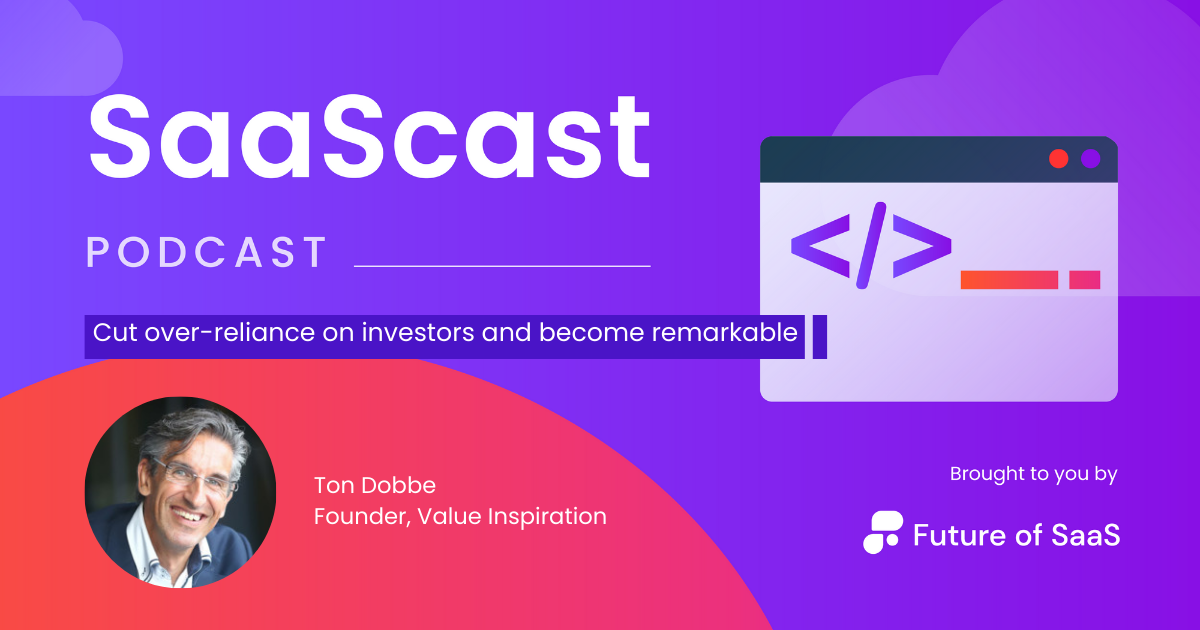This article comes from Ton Dobbe’s insightful SaaScast episode, ‘Cut over-reliance on investors and become remarkable’, check out his full discussion here
After nearly 30 years of developing enterprise platforms, I realized I cared more about helping startups avoid our mistakes than rebooting another legacy company from the inside.
Now, nearly seven years into running my own consultancy, I’ve seen too many founders obsess over fundraising as the only path to scalability.
But in reality, this narrative ignores the root causes actually behind sustainable growth, over-reliance on capital doesn’t guarantee 'remarkability' or retention.
More often than not it distracts from the customer traction and recurring revenue that ultimately decide fates in the hyper-competitive SaaS space.
In this article, I’ll share why the dominant VC scaling mindset is ultimately flawed, and how customer-centric bootstrapping accelerated my success.
My aim here is to help SaaS leaders build durable businesses by putting logical problem-solution fit above fundraising mania.
Let’s dive in!
Start with creating lasting value
When starting a company, the temptation is strong to focus on quick exits and fast cashouts. But real, sustainable success comes not from flashy headlines, but from solving real problems for real people.
I've learned over my career that the best place to start is by deeply understanding which critical customer pain points I can relieve better than anyone else. That’s how you reveal the big opportunities that are worth pursuing over the long term.

Vet these ideas substantially before deciding if spinning up a standalone business makes sense right away.
Stay scrappy and laser-focused until you can nail those user needs 10x better than alternatives through very focused positioning and smart trade-offs. Deliver so much observable value that your solution essentially sells itself.
Outside funding can accelerate impact substantially at the right junctures, but it should complement rather than fully compensate for real substance.
Why premature fundraising often backfires
With relatively easy access to venture capital in recent years, many founders raise substantial sums before truly proving out their ideas with customers.
They sell big, ambitious visions trying to excite investors without much concrete evidence that their solution is truly a must-have for a specific set of users.
Some do gain enough temporary buzz in the market to raise inflated seed rounds or unicorn valuations out of the gate. However, once-agile startups loaded down with overstuffed budgets often turn sluggish later on across too many distracted experiments.

In this state, founders often lose sight of the core customer traction and signals that drive sustainable long-term growth. Trust me, I’ve seen way too many once-promising startups flame out this way.
They reactively scramble to appease impatient investors by chasing vanity metrics that don’t map to delivering actual user value.
Real progress comes not from breadth, but depth - earning revenue by sharply solving focused needs with simple products that users inherently want right away.
Watch out for vanity metrics that don’t convert
Many founders fundamentally mistake vanity metrics for reliable signals that a sustainable business is emerging.
Flashy metrics like registered users, event attendance, social media fans, press mentions, and application downloads alone won’t build viable long-term businesses no matter how broad their reach might scale early on.
The signals that matter most come from those who ultimately convert to paying customers, anchoring your solution as an indispensable part of their workflow.

Without that focused product-market fit and differentiation, you’ll likely leak cash trying unsuccessfully to manufacture enough transaction volume and scale.
Lasting SaaS success rewards not breadth, but depth - delivering quantifiable and observable value tightly aligned with a well-defined set of customer jobs-to-be-done.
Don’t take growth for granted
After achieving fantastic early traction, many potentially successful SaaS companies sadly lose the intense hunger and innovative edge that made them remarkable market leaders initially.
As founders and executives bask too much in recent accolades and strong metrics, the internal bar often stops rising quarter-to-quarter.
Leadership starts believing they’ve sufficiently “arrived” at solving customer problems while losing sight of what’s still ahead to improve users’ lives exponentially better through new innovations.
In this state of complacency mixed with a bit of arrogance, internal teams also turn reactive and incremental, merely checking boxes on product roadmaps.

With limited serious competition, they stop re-inventing their customer experience substantially ahead of the curve. They optimize to protect what already exists rather than invent what could be.
However, to sustain market leadership in technology over time, you have to stay obsessively focused on relentless, exponential innovation quarter-to-quarter.
By the time stagnating customer usage metrics eventually start to expose cracks in the solution, one or more new challengers have typically emerged with an extreme focus on evolving user needs and jobs-to-be-done.
Those new entrants have already outpaced incumbents with substantial product differentiation built for the next era ahead.
The best way to avoid this fate is doubling down relentlessly on existing product-market momentum rather than protecting it.
Keep growing by continually re-quantifying and improving the core value delivered to users based on their subtle shifts over time, and most importantly, never take growth for granted!
Sell outcomes, not features
The hardest product trap SaaS companies fall into is losing touch with what specific user outcomes their features enable. Founders forget their special sauce making lives remarkably easier.
In the enterprises I‘ve helped transform, the tendency was always to incrementally fill gaps based on client requests, and whilst important, this reactive approach rarely created sustainable differentiation.
We found the way to break out was flipping problem identification. Instead of asking “What features are missing?”, we asked, “What single monumental outcome do our users want but lack?”

Once we found a frustrating goal that was universally shared but unsolved, we filtered existing roadmaps through that lens. We realized much work delivered minimal value toward that north star metric.
By saying no to distractions, we realigned on what created true remarkability.
The result was we revamped messaging and positioning fully around enabling that transformative end result for a well-defined audience. We built integrated experiences that compounded value on solving related barriers standing in their way.
This is what I coach SaaS companies on - niche down user segments, uncovering their ultimate unsolved jobs-to-be-done, then align all energy on delivering that monumental outcome better than anyone else.
Building for outcomes maximizes remarkability.
Key takeaways
By bootstrapping early and staying laser focused on underserved customer needs, you give your company the best chance at building remarkability that grows over time no matter what surprises arise. Outside funding at the right junctures can turbocharge impact, but it will never replace focus on value creation - the one factor that ultimately decides SaaS winners.
That’s how you build a durable business destined to defeat inflated imposters. Root your foundations on quantifying how much better you’re making customers' lives through obsessive problem-solution fit. The rest takes care of itself!
Why not check out the full podcast chat right here? 👇



